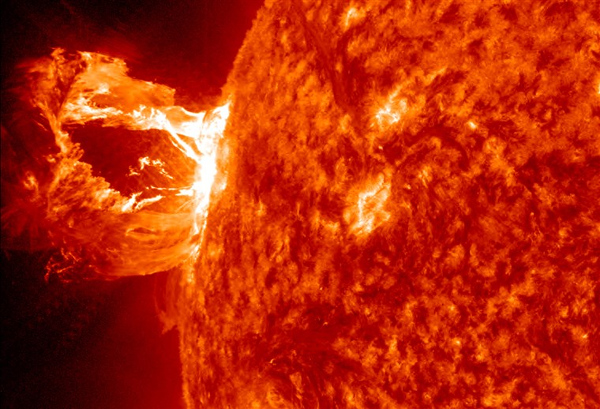New Delhi: Scientists at the Indian Institute of Astrophysics (IIA) and Raman Research Institute (RRI) autonomous institutions of the Department of Science & Technology (DST) recently established that the flare energy release is fragmented in both time and space.
A solar flare occurs when magnetic energy that has built up in the solar atmosphere is suddenly released. Though it has recently been found that solar flares are not homogeneous processes, but made up of a number of small energy releases, it was not clear whether the fragmented energy release is because of a single release region accelerating electrons at a highly variable rate or activation of many different release regions.
The study by R Ramesh, IIA, V Mugundhan, RRI and K Prabhu, IIA, found that the release is broken and spans both over multiple locations and at different times. This finding can help us form a better understanding of time and location of solar flares that affect the ionosphere and radio communications on Earth and also release energetic particles into space. The findings were published in the journal The Astrophysical Journal Letters.
Many observatories worldwide are engaged in monitoring the Sun in the spectral line (commonly referred to as H-alpha line) for flares. Solar and stellar coronae are very dynamic plasmas on various time scales from hours to few tens of microseconds. The time scales reflect different processes of energy release.
Solar flares are the most powerful magnetic events in the solar system. In tens of minutes, they can release more than 1,032 erg of energy. They emit radiation across the entire electromagnetic spectrum, from radio to gamma rays. The 3→2 Balmer transition line of neutral hydrogen, centred at 6,563 Ao, is historically important in flare observations and has a rich diagnostic capability.
In recent years, the most notable of these processes, the flare, has been found to be not just one homogeneous process but is made up of a number of small energy-release events. Until the report of the present work, distinguishing whether the above-fragmented energy release is due to time evolution of a single energy release region accelerating electrons at a highly variable rate (temporal fragmentation) or the activation of many different release regions (spatial fragmentation) triggered by an initial disturbance, was rare.
Taking advantage of the simultaneous observations of the Sun with the H-alpha telescope at the Kodaikanal Solar Observatory (Tamil Nadu) and at low radio frequencies with the telescope in the Gauribidanur Radio Observatory (near Bangalore in Karnataka), the scientists at IIA (which operates the aforesaid two facilities) recently established unambiguously that the flare energy release is fragmented in both time and space. For the first time, the inter-pixel changes in the respective data sets were investigated using a novel data processing technique to infer the above.
These results are important to understand whether the energetic particles released during a flare are guided into the corona and interplanetary space from a single location in the solar atmosphere or simultaneously from multiple locations.
The radio and flare centroids were obtained from observations during the interval ~ 06:48-06:54 UT. Solar north is straight up and east is to the left. The two bright spots inside the green box correspond to the flaring activity in the active region AR12259. Inset ‘a’ shows its zoomed view and the locations of the type III burst centroids (‘+’ symbol). Inset ‘b’ shows the locations of the flare centroids (‘x’ symbol) with respect to the same brightening.
Source: Indus Dictum
Image Courtesy: NBC News
You may also like
-
New Heat-Based Approach To Cancer Treatment Can Reduce Chemotherapy Doses
-
Scientists Take A Major Step Towards Unification Of Classical & Quantum Gravity
-
India Graphene Engineering and Innovation Centre (IGEIC) Under the Vision of Viksit Bharat@2047 Launched
-
New High-Performance Gas Sensor can Monitor Low Level Nitrogen Oxides Pollution
-
Antidepressant Drug can be Repurposed for Treating Breast Cancer
